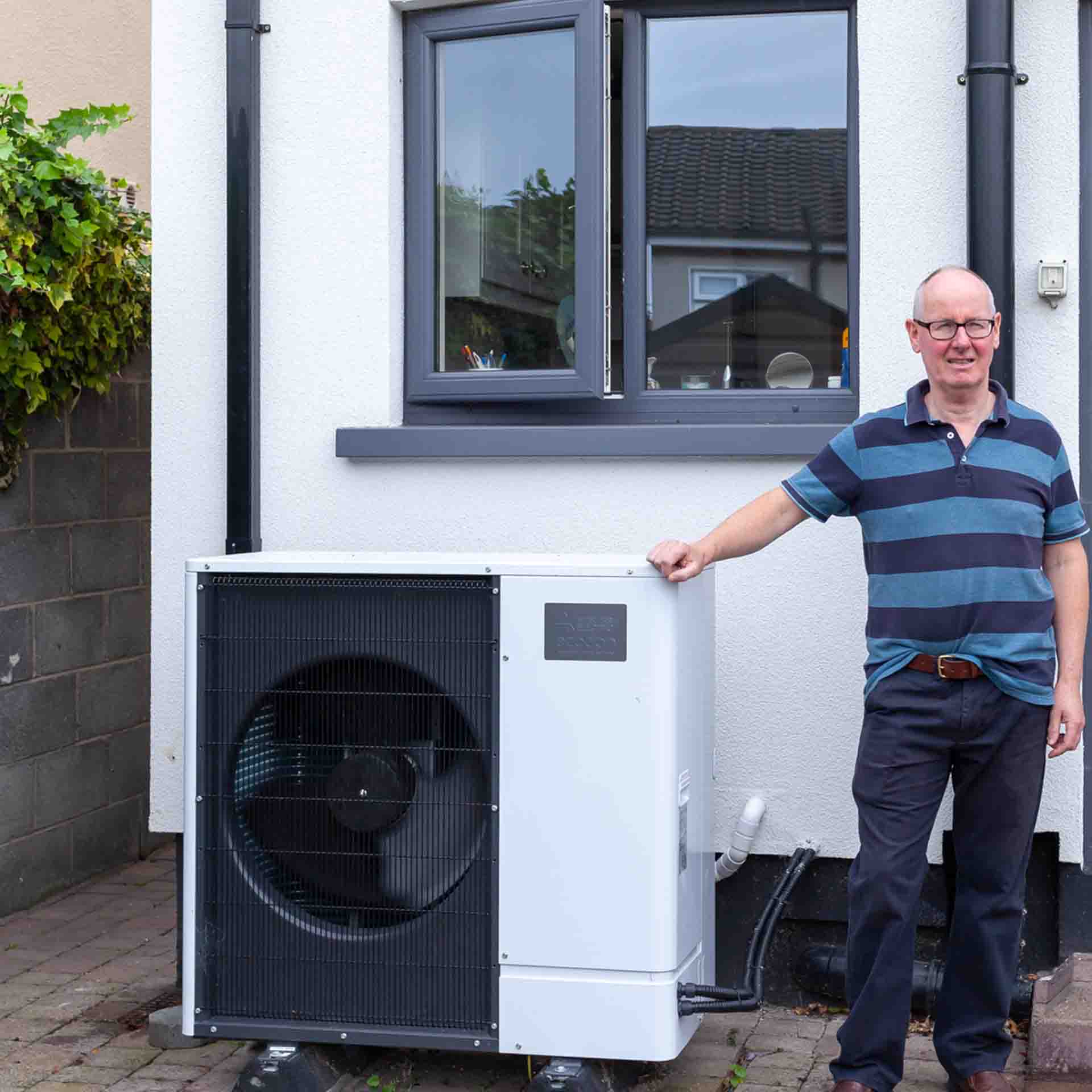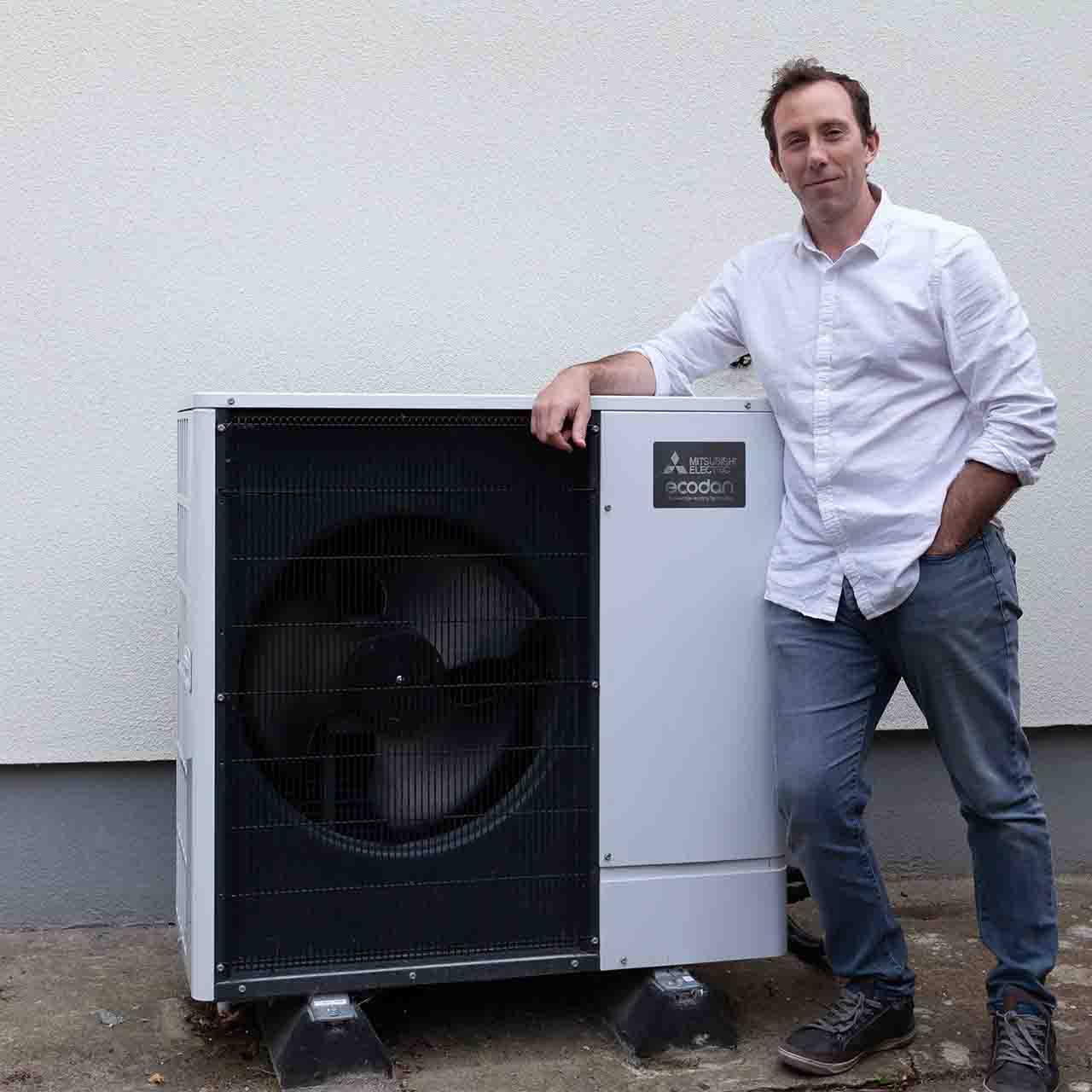Why choose a
heat pump?
Avail of up to €4554.40 in grants.
Reduce your heating bills by up to 50%..
And enjoy a more comfortable home.

Avail of up to €4554.40 in grants.
Reduce your heating bills by up to 50%..
And enjoy a more comfortable home.

By installing a heat pump you’ll save money on your heating bills, reduce your carbon emissions and enjoy a warmer, more comfortable home. More than that, you’ll be future proofing your home.

Simply put, a heat pump is a device that uses a small amount of energy to move heat from one location to another. While you may be unfamiliar with how a heat pump works, you’ve already been using the technology for years. In your fridge. Only a heat pump works in reverse.
There are two main types of heat pumps. Ground source and air source. Ground source heat pumps source their heat from the ground. And air source heat pumps, yes you’ve guessed it, source their heat from the air. Air source heat pumps are the type that we specialise in.
The main unit of a heat pump will be located outside your home. The heat pump uses a fan and a coil of tubing filled with refrigerant to grab heat from the outside air and convert it into a gas form. The compressor, as you might expect, compresses the refrigerant gas to produce heat. This heat is then passed along to the the heat exchanger within your home. From here it is distributed throughout your house. Either via underfloor heating, or more popularly, through

Typically it’ll cost between €10,000 – €12,000 to install a new heat pump. This figure doesn’t include additional costs such as laying new pipework if your existing pipework needs to be replaced.
The good news is that that Sustainable Energy Authority of Ireland (SEAI) and Electric Ireland both provide significant grants, totalling €4554.40, for the installation of a heat pump. The grant however does not include any upgrading of central heating piping that might be nessesary in your home.

The beauty of a heat pump is that it maintains a constant temperature throughout your home. No surges of heat. A nice, warm comfortable level. All day long.
Using your heat pump in a similar way to a conventional central heating system will use more electricity and be expensive to operate.Instead it’s better to set your heat pump to heat the home slowly over a longer period at a lower temperature.
To reduce your electricity costs, you should make sure you’re on the right electricity tariff. With all our heat pump installations we provide a free, 12 month monitoring service. This will give you the peace of mind that your home is being heated correctly, the heat pump is operating efficiently and allow you to avail of the most competitive energy tariffs. .
A regular service will also help ensure you’re getting the best performance from the system.

It is a requirement of the SEAI and Electric Ireland funding that your home has low heat loss. This is to ensure your heat pump system performs as best it can and that your electricity bills are not too high.
Before applying for a heat pump grant, you’ll need to have a BER and technical assessment carried out of your property, by a registered SEAI technical advisor.
A technical assessment will establish;
Should your home is not heat pump ready, the assessment will outline the measures needed to bring it up to the standard. Which could include roof and wall insulation and door and window replacements.

Location, location, location.
Where your heat pump is located matters. Typically the heat pump is located at the side of a house, with enough room to access for maintenance and away from doors and windows so as not to cause an obstruction. Heat pumps can either be wall mounted. Or if space allows, placed on the ground close to a side wall.
Heat pump size.
As you might expect, different size homes require different size heat pumps. We offer four sizes. 5kw up to 14kw. Most houses fall into the 8.5kw to 11kw range.
Hot water cylinder tank size
It’s not always necessary to replace your hot water tank when you have a heat pump installed. However if you do require a new hot water cylinder, the cylinder size is calculated on the households hot water requirements. For example the hot water requirement of a 100m2 house with 3 occupants and one bath would, on average, require a 170 litre hot water tank.
Radiator Sizing.
Heat Pumps tend to work best with oversized radiators. This is good news as it often means that the existing radiators don’t have to be replaced. Especially in Irish homes. Radiators should be sized for each room, based on the room by room heat loss calculation conducted during the technical examination.
Additional Piping.
During the technical assessment, it may be revealed that your central heating piping needs to be replaced at it’s too old or not in a good enough condition to operate effectively. Installing a heat pump but having sub par piping will result in you losing heat through your piping and the heat pump not operating to its full potential. Which would defeat the purpose of having the heat pump installed in the first place.
Technical Adviser visits your home
A registered SEAI technical adviser will visit your home to carry out a technical assessment to see how suitalbe your home is for a heat pump. During the technical assessment your technical adviser will
Radiators Examined
Examine the radiators to make sure that they meet the required efficiency standards and that they are suitably sized to provide the required heat output at a lower temperature.
Heat Loss Assessment
The required radiator size for a heat pump installation on willl be calculated on a room by room, heat loss basis.
Heat Output Comparison
The requirements of the heat pump are then compared with the existing output of the radiators in your home.
Pipework Examined
Finally the technical assessment will examine the existing pipework to make sure that it is in good condition.
The most popular heat pump in Ireland.
There is a total of €4554.40 . in grants available from the SEAI and Electric Ireland

















This site uses cookies. By continuing to browse the site, you are agreeing to our use of cookies.
OK